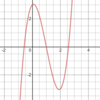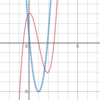June 8 and Later Flashcards
(106 cards)
𝚫
means
_____.

Average rate of change
is associated with
[tangent / secant].
secant
Instantaneous rate of change
is associated with
[tangent / secant].
tangent
Touching at one point
is associated with
[tangent / secant].
tangent

Derivative
is associated with
[tangent / secant].
tangent

𝚫f = f(x2) − f(x1)
𝚫x x2 − x1
is associated with
[ instantaneous rate of change /
average rate of change ].
average rate of change
𝚫f = f(x2) − f(x1)
𝚫x x2 − x1
is associated with
[tangent / secant].
secant
lim𝚫x→0 𝚫f
𝚫x
is associated with
[ instantaneous rate of change /
average rate of change ].
instantaneous rate of change

df (x)
dx
is associated with
[ instantaneous rate of change /
average rate of change ].
instantaneous rate of change

To talk about
instantaneous rate of change,
you must specify a
_____.
location
To talk about
average rate of change,
you must specify an
_____.
interval








Envision a
- *graph** of how the definition of
- *derivative** works?

The
equation for
average rate of change is below.
How does it relate to the
equation for
instantaneous rate of change?


This
lim𝚫x→0 f(x + 𝚫x) − f(x)
𝚫x
may be
described verbally as
“the limit of the
_____ of f(x) over the interval [x, x + 𝚫x] as
𝚫x→0.
average rate of change
This
lim𝚫x→0 f(x + 𝚫x) − f(x)
𝚫x
may be
described verbally as
“the limit of the
average rate of change of f(x) over
the interval
_____ as 𝚫x→0.
[x, x + 𝚫x]

To
evaluate a limit,
i.e.
limx→1 √(x2 + 4) − 2
x2
- *first**
- *_____**.
plug in the limit point value
(here, x = 1)
In
evaluating a limit,
i.e.
limx→1 √(x2 + 4) − 2
x2
if you
plug in the
_____
and get a
well-defined result,
that’s the limit.
limit point value
In
evaluating a limit,
i.e.
limx→1 √(x2 + 4) − 2
x2
if you
plug in the
limit point value
and get a
_____,
that’s the limit.
well-defined result
How would you write this
lim𝚫x→0 f(x + 𝚫x) − f(x)
𝚫x
in
Leibniz notation?
df (x)
dx
How would you write this
lim𝚫x→0 f(x + 𝚫x) − f(x)
𝚫x
in
prime notation?
f’(x)

























































